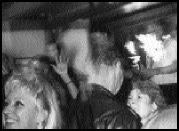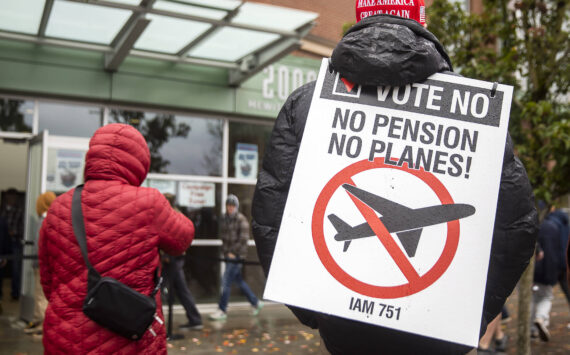WHAT COSTS $1.02 billion, has been up and running since September 2000, and has been nearly overlooked by critics of public transportation? The Sounder commuter rail line from Seattle to Tacoma.
While Sound Transit’s detractors have occupied themselves with the agency’s troubled light-rail project, Sounder, the agency’s commuter rail service, has been moving steadily forward for more than a year. Sounder, which runs on 40 miles of track owned by the Burlington Northern Santa Fe railroad, connects the Emerald City and the City of Destiny, with stops in Puyallup, Kent, and Tukwila; Sound Transit hopes to expand the system north to Mukilteo, Edmonds, and Everett and south to Lakewood within the next few years.
For thousands of commuters who live south of Seattle, Sounder is the answer to years of prayers. It whisks suburbanites past miles of clogged arterials and can cut hours off a rush-hour commute between Tacoma and Seattle. Packed so tightly on a recent Friday night that some passengers had to stand for the first few legs of the Seattle-to-Tacoma jaunt, Sounder is a marvel of modern transportation: You can sleep, plug in your laptop, or sit and do crosswords on one of the train’s dozens of tables. There’s little doubt that few passengers would go back to driving, given the alternative; many, such as Puyallup resident John McKay, used to sit through grueling commutes of up to three hours. “I used to have to leave the house at 5 a.m. to make it to work on time,” says McKay. McKay even credits Sounder with helping him lose 70 pounds. “I’d have to drink three mochas on the way in and three doubles on the way back” to stay awake, he says. Now, he just sleeps on the train.
But for all its charms, is Sounder worth the price? Can a commuter rail system that carries just 2,400 one-way passengers daily in posh, climate-controlled comfort justify losses of up to $27,000 a day? And how long should commuters expect to wait for a system that has been consistently over budget and behind schedule for six years running?
As is often the case with expensive, long-term projects like public transit, the answers aren’t simple.
FOR EXAMPLE, no one at Sound Transit denies that Sounder has missed nearly every deadline it has set—from its initial projection that service to Tacoma would begin in “late 1999,” according to a 1997 press release, to assurances that commuters from Everett would be riding the train by early 2001. By now, nine trains were supposed to be running between Lakewood and Seattle, and six between Seattle and Everett, for 30 one-way runs a day. Instead, Sounder only makes four one-way trips between Seattle and Tacoma: Two trains leave Tacoma at the brutal hours of 6:15 and 6:45 a.m. and depart from Seattle at 5:10 and 5:45 p.m.— inconvenient hours for many commuters.
But, as Sounder’s interim director, David Beal, points out, there have been reasons for the delays—chief among them the difficult negotiations over track improvements and right-of-way with Burlington Northern, which owns the 82 miles of track between Lakewood and Everett. Burlington Northern uses these tracks to run freight trains all the way up and down the West Coast and east toward Chicago. Since the rail company owns the tracks and the Tacoma freight yard used by Sounder, it gets to make the rules. “I think it’s fair to say they’re in the driver’s seat,” says Beal. “They’re not required to let us run more than two round- trips per day.” But even if Burlington Northern does need the tracks, asserts Kent transit planner Mike Skehan, they could run more trains if they wanted to. Union Station, where Sounder stops in Seattle, “used to handle 100 passenger trains per day nearly 100 years ago,” Skehan says.
Burlington Northern is also part, though not all, of the reason that Sounder has run nearly a quarter-billion dollars over budget since its inception as part of the Sound Move plan approved by voters in 1995. Since Burlington Northern owns the tracks, the railroad decides how much they’re worth; not surprisingly, current cost estimates for track construction and improvements are millions over original projections. Lowball cost estimates for everything from administration to station construction also added dramatically to Sounder’s red ink. For example, the original budget allocation for station construction turned out to be nearly $78 million short of current projections; the cost of the Kent station went up by nearly $28 million “primarily,” according to the Sounder budget, “to cover the additional costs of parking” at two stations. At Sounder’s temporary station in Tacoma, commuters sprint toward a six-story garage the moment the doors slide open; meanwhile, Pierce Transit buses sit looking empty and a little forlorn outside. “Little, if any, money has been spent on improving bus shelters to entice patrons to leave their cars at home,” Skehan says. And the trains are still strictly for suburban commuters; to get this reporter back to Seattle from Tacoma on a Friday night, Sound Transit had to send a car.
The overruns have added up. Currently, the system costs about $32,000 a day. Passenger fares add up to only around $5,000, or about 16 percent of Sounder’s operating costs; Metro bus fares, in comparison, pay for about 25 percent. Sound Transit, critics charge, is spending too much money for too little service. “We could probably subsidize free, door-to-door taxi service [for Sounder riders] for the same cost” as the train, Jim MacIsaacson, a local transportation planner, says.
Sound Transit’s Beal defends the Sounder subsidy by offering more assurances: “Once we’re at 30 trains a day, we’ll actually be at around [a] 32 percent [subsidy].” But that assumes that all 30 trains start running in the first place—and that they’re as popular as the ones that currently run between Seattle and Tacoma.
That’s a mighty optimistic set of assumptions. To make its projections of 3.2 million passengers yearly by 2010, Sounder would have to increase its ridership by nearly 25 percent a year for the next nine years. “Highly unlikely,” MacIsaacson says, even if the trains do start running on schedule. According to Fran Hooper of the American Public Transit Association, ridership on commuter rail systems nationwide is growing steadily, especially on growing systems like Sounder, but only at an average of 4 percent a year.
Critics also like to point out that Sounder doesn’t take cars off the road— it just converts bus commuters, who were using transit anyway, to train riders. Between Everett and Seattle, Sounder would decrease traffic in the I-5 corridor by less than a third of 1 percent. But Beal says critics who focus on traffic are missing the point: “Sound Transit was always clear that what it was providing was an alternative to congestion, not a solution to congestion.” If people can drive, Beal reasons, they will. “There’s a latent demand that’s waiting to get to a mall if there’s an easy way to get there,” he says. As for bus ridership, Sound Transit spokesperson Lee Somerstein says that, too, has increased between Tacoma and Seattle. “If a bus rider does switch to a train, that opens [bus] capacity for new riders,” Somerstein says.
SOUND TRANSIT will have to more than just sell its train to commuters and a wary public. Burlington Northern, which drove a hard bargain on Sounder’s use of the tracks to Tacoma, has, some say, even less reason to negotiate over use of tracks to Everett- a series of single-track bottlenecks already clogs the rails several times a day. Sounder would add 12 trains daily to the congested route. Meanwhile, Burlington Northern is “raising concerns about freight capacity” between Seattle and Everett “because there’s more demand than what the railroad and Sound Transit anticipated,” says King County Council member Rob McKenna, who sits on the Sound Transit board.
According to the Transit Association’s Hooper, friction between transit agencies and railroad companies is always “one of the toughest parts” of running a commuter system. “The passenger service has to be scheduled when people want to use it, and the freights have their customers that they have to serve,” Hooper says. “The question is, can you be creative when you serve those customers on both sides?”
Sound Transit’s Beal says the biggest point of contention has been “what kind of capital improvements we help to build along the line.” Burlington Northern wants Sound Transit to “help” with more than 20 projects, while Sound Transit, for obvious reasons, would like to see that number shrink.
One thing both Burlington Northern and Sound Transit agree on, however, is the need for a second track along two critical stretches, amounting to about three miles of additional rail. That track, which would run along the shore overlooking Puget Sound, was the topic of a lawsuit earlier this year by a group called Save Our Shoreline, which alleged it would endanger visitors to public beaches north of Seattle, vastly increase the number of freight trains through the area, and cut off access to miles of shoreline, according to Jeff Thomas, an attorney for the group. “They’re going to start tripling or quadrupling the trains during the only periods-before and after work- that people have to use the beaches,” Thomas says.
Beal counters that the real restriction on train traffic isn’t north of Seattle; it’s east, where a narrow mountain pass limits traffic to 28 or 30 trains a day. As for the environmental concerns, Sound Transit’s Beal says critics, including regulatory agencies, will likely be “very supportive” of Sound Transit’s plan for environmental mitigation.
Whether the battle will be worth the effort is another question entirely. Long-term projections call for the 12 trains on the Everett-Seattle corridor to carry a paltry 1,500-2,000 riders daily by 2010, at a cost (over 10 years) of $182 million. By 2021, that figure will have grown only to about 3,600. The reason, according to Beal, is that the population centers that exist north of Seattle are not on the shoreline.
The ridership between Seattle and Everett, McKenna points out, is “the equivalent of about three bus routes.”
But buses, Beal counters, aren’t nearly as reliable as rail transit, which isn’t affected by freeway traffic. And, in fairness to Sounder, people should remember that transit systems tend to pay off in the long term, not in 10 or 15 years, Beal says. “Ultimately, in 20, 30, 40 years, people don’t look back and say, ‘Look at what this thing cost.’ People can’t imagine what it was like when it wasn’t there.” Clearly, Beal hopes Sounder’s performance will be judged using the same yardstick.







